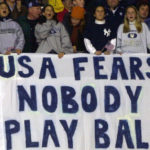You Want Speedier Games? Limit Pitching Changes—Part I
 This is the fist installment of a three-part series taking a look at baseball’s pace of play. See Part II.
This is the fist installment of a three-part series taking a look at baseball’s pace of play. See Part II.
In many ways baseball seems like it hasn’t changed since it established its modern rules in the 1880s. Since the flat pitching box became a sloped pitching mound. Since pitchers were allowed to move and adjust their bodies so they could throw overhand, rather than underhanded—the way they threw the first 20 years of professional baseball.
Or since the first breaking pitch was thrown in the 1870s by Candy Cummings. Since the National and American Leagues joined together to form major league baseball in 1903. Since Jackie Robinson broke the color barrier in 1947 and the American League adopted the Designated Hitter rule in 1973. And since the gradual modifications in pitching over the years that changed the way pitchers were used. Since starting pitchers became less important than relief pitchers, save for those few pitchers who could throw more than 200 quality innings in a season. And that group has become an endangered species.
So, baseball has changed dramatically. Which is why the game seems to have slowed down. Too many movements within the mechanics of the game. As fast as baseball is today (and parts of the game are very fast and exciting), the world that baseball is wrapped within moves even faster. Baseball does not move at the speed of today’s world. It’s still a slow, beautiful waltz around the dance floor. The music’s sensual, the dance steps are brilliant and the choreography unique. The entire presentation of the game is compelling, but the games are not what they once were.
In this high-speed 24×7 society we live in, news cycles that once took weeks now take minutes, if not hours. Globalization has increased the flow of information from place to place in nanoseconds. From the Pony Express which delivered the mail in the early months when professional baseball first debuted to instantaneous email and text messaging today.
Even the way baseball is reported is now immediate. No matter where the game is played, game situation, score, player milestones—all of it is available in real time. Immediately. No matter where you are or the time of day.
Real-time baseball information. There was no such thing until ESPN debuted in the early 1980s. And even then that animal is nothing compared to what real-time means today. Live look-ins into any game being played (on MLB.tv). A player is about to hit 3,000 hits, his at bats are shown live as they happen. Every at bat until the 3,000th hit occurs.
Baseball games may still be slow, because that is the nature of baseball. But the game within a game is incredibly fast. So much so that announcers now have incorporated the word velocity—or ‘velo’ for short—into the language of the game. Radar guns have been referred to for years to indicate the speed of pitches. In-game graphics routinely show the speed of the pitch, as well as the number of pitches that a pitcher has thrown.
And now launch angles and velocities are displayed for home runs or line drives—or almost anything hit by Aaron Judge and other sluggers who drive the ball with incredible intensity. So, even if the overall game is still slow at times, individual aspects of the game are faster than ever. And incredibly exciting for the fleeting seconds they occur.
But when relief pitchers enter the game, it slows down, dramatically. Perhaps because they’re all about too much velocity and too little craft. And not all relief pitchers control their fastballs with the same precision. When the ball is all around the plate, the pace of the game sputters. Truth is, pitching is not velocity alone. Triple digits on the radar gun are not enough to pitch effectively. Pitchers require velocity plus movement and location to be successful. So, fastball control is critical, as are viable secondary pitches that can be thrown for strikes. Someone should tell this to relief pitchers.
The rookie Jordan Hicks of the St. Louis Cardinals has thrown a fastball 105.1 mph this season. He’s making Aroldis Chapman seem ordinary at 101. And there are more and more bullpeners all over baseball who can rear back and fire a ball faster than a speeding bullet (give or take a few mph).
According to MLB Statcast, only Hicks of St. Louis, Chapman of the Yankees and Tayron Guerrero of Miami (and his delivery is smooth as silk) have thrown pitches faster than 100 miles an hour in 2018. But many others step on the mound and bring the ball 95 to 100 mph. It’s almost ho-hum.
What isn’t ho-hum are the Stu Millers and the Jamie Moyers of the baseball world. No team seems to have pitchers of this sort in their bullpens anymore. The slow and slower and slowest pitchers. Who challenge hitters by throwing the next pitch slower than the one before.
I still remember Steve Hamilton’s eephus pitch that some called the “folly floater,” as it took its sweet time rising and then falling through the strike zone. When he threw it well, it completely fooled the hapless hitter. He threw the eephus in the 1960s and early 1970s, mostly for the New York Yankees, as a competent left-handed relief pitcher on what were mostly incompetent teams.
When people complain the games are too long, and sometimes they are, they’re missing the point. Baseball has sped up dramatically. Now there are even stats about the time it takes batters to reach first base. Differentiating between fast and incredibly fast players. And there are a lot of incredibly fast players in baseball.
But the mechanics of the game still require three strikes or four balls before an at-bat ends, unless the batter puts the ball in play before either of those numbers are reached. Really good hitters work deep counts and see five, ten, sometimes more pitches, wearying starters.
And that’s when the game begins to really slow down, when relief pitchers take over the game.
Continue reading Part II

























